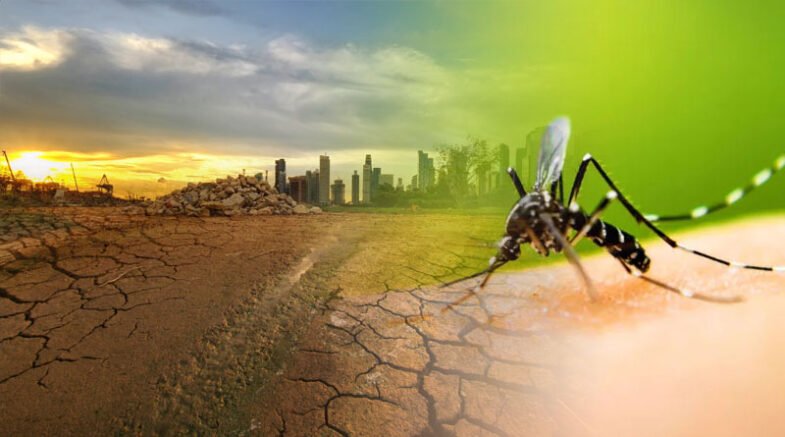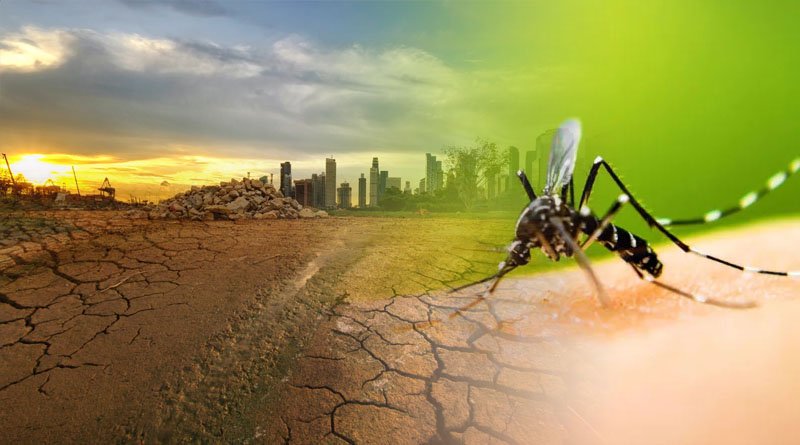Global climate specialists concur that anthropogenic activities have had a significant impact on the rise in atmospheric greenhouse gas concentrations and the extinction of ecosystems.

The introduction and reemergence of parasitic diseases are extremely alarming, yet they receive less attention than certain other effects of climate change.
Although climate change is a naturally occurring phenomenon, human activities have had a substantial impact on changes in atmospheric conditions, speeding up the process and contributing to the current precarious situation.
Global climate specialists concur that anthropogenic activities have had a significant impact on the rise in atmospheric greenhouse gas concentrations and the extinction of ecosystems.
Extreme weather events like variations in temperature and precipitation make it easy to identify the direct effects of climate change, but indirect effects are more difficult to see. Climate change will have severe negative effects if the endemic range of parasitic illnesses expands or changes.
Given that habitat destruction and ecological disruption are contributing factors in the spread of disease, it may also be our carbon footprints. Temperature increases and weather patterns are directly impacted by climate change, which indirectly may influence the geographic distribution of disease vectors and human populations.
Temperature rises encourage the growth of the parasites themselves as well as the arthropod vectors that convey many different parasitic organisms. The range of reservoir hosts, vector abundance, bite rates, overall survival, and rates of parasitic transmission of vectors, including mosquitoes, ticks, and tsetse flies, all rise in a warm climate.
Because tropical and subtropical climates encourage species diversity and can thus sustain a wide range of possible hosts for parasitic diseases, parasitic diseases are frequently a burden on these societies. The ability of parasites to survive and thrive depends on complex host relationships, which can be changed by a changing climate, increasing the risk of infectious diseases.
The natural ranges of these creatures may change or expand because of climate change, potentially bringing parasites to parts of the world that were previously uninhabitable. Changes in temperature alter the life cycles of parasites, which can directly affect how prevalent the organism is within the area, given that many parasitic organisms have a temperature-dependent developmental baseline, either within their host or in the environment.
The introduction and reemergence of parasitic diseases are extremely alarming, yet they receive less attention than certain other effects of climate change. By encouraging a positive feedback loop of poverty and economic stagnation in the places they are most likely to touch, these diseases frequently do more than just directly worsen human health by lowering the general quality of life.
Mosquito prevalence is heavily dependent on precipitation levels that promote mosquito breeding places and adequate temperatures for surviving. Due to the high rates of morbidity and mortality from these infections, sub-Saharan Africa and other endemic regions of the world have developed conditions that mosquitoes can use to transmit infections like malaria.
In locations bordering regions where parasitic diseases are endemic and put the inhabitants there in danger, these characteristics can vary as the climate changes. Due to the lack of acquired immunity and the severity of the clinical illness, certain diseases pose even higher hazards when they spread to other locations.
The possibility of the spread of other parasitic diseases carried by mosquitoes increases with climate change. Moisture levels in the soil and plant canopy can be used to map the location of lymphatic filariasis since they can serve as indicators of mosquito larvae breeding grounds. Soil moisture levels and accompanying mosquito populations will alter because of changes in temperature and precipitation patterns.
According to an ecological niche model developed to examine the potential distribution of lymphatic filariasis in Africa, the number of people at risk of infection could rise from 543 to 804 million—an astounding 1.65 to 1.86 billion as early as 2050, depending on how severe future climate change is.
Chagas disease is a widespread ailment in rural areas of Latin America and is spread by triatomine bugs. In the southern United States, triatomine insects are also highly prevalent.
In areas of the southern United States where the illness first appeared locally more recently, Chagas is now spreading further north. This is most likely because of rising temperatures, immigration, and international travel.
The United States is home to at least 11 different species of triatomine insects, as well as various reservoir host species like woodrats, racoons, skunks, and coyotes. Due to “colonias,” low-income communities in Texas that are known for their shoddy construction of dwellings and sanitation systems that would give habitat for the insects and easier access into people’s homes, certain counties in Texas are particularly at risk.
The behavior of triatomine insects might potentially alter as a result of shifting climatic conditions. When temperatures rise over 30°C and humidity levels are low, triatomine insects often feed more frequently to prevent dehydration.
It has also been shown that triatomine insects may adopt shorter life cycles as interior temperatures rise, enabling them to enhance their population density and boost the likelihood of disease transmission. Several studies have shown that rising temperatures cause some vector hosts to grow Trypanosoma cruzi, the disease-causing parasite, more quickly.
The ranges of tsetse flies were also predicted under several climate change scenarios, and while their ranges aren’t anticipated to grow considerably due to climate change, they are anticipated to alter significantly. A wider population may be at risk of developing Trypanosoma brucei or human African trypanosomiasis because of these range alterations.
Tsetse fly populations, for instance, are declining in Zimbabwe because of vector control measures combined with high temperatures that could be harmful to the flies’ ability to survive. However, habitat fragmentation still raises infection and disease risks, even though it may result in higher populations of older flies.
Adding to this is the preponderance of sand flies, an insect vector for leishmaniasis, encompassing a spectrum of clinical manifestations of variable prognosis that range from skin ulcerative lesions around the infection site, called localized cutaneous leishmaniasis, multiple nonulcerative lesions, called diffuse or disseminated cutaneous leishmaniasis, and severe disfiguring mucosal metastatic disease. There are numerous accounts of native leishmaniasis in people who have never left the country.
With the effect of climate change contributing to an increased range for sand flies and flies being found in new locales, in addition to servicemen and women who served in the Middle East and may have been exposed to infection returning home, the opportunity for leishmaniasis in North America to expand both substantially and dramatically is now becoming a reality.
It is well known that seasonal variations in Leishmania infection rates exist in some parts of the world. Ecological niche models additionally suggested that suitable habitat for sand fly vectors would spread, raising the risk of leishmaniasis in regions where it is not endemic now.
Human exposure to leishmaniasis is expected to at least double in the United States by the year 2080, even under the strictest model conditions. This threshold, however, should be crossed much sooner than anticipated given the rates of human migration and worldwide civil unrests causing large migrations of individuals from endemic areas to nonendemic portions of the world and international travel.
Although the Ixodes tick species are likely best known for being carriers of pathogens like Flaviviridae (tick-borne encephalitis) and Borrelia burgdorferi (Lyme sickness), they are also carriers of the protozoa that cause babesiosis. Higher than average precipitation during late spring or early summer certainly enhances tick activity and increases survival rates in the Northeastern United States.
A changing climate, which included milder winters and extended spring and fall seasons compared to the 1980s, was linked to a northern shift and increase in Ixodes tick populations in Sweden in the 1990s. Similarly, Canada and portions of subarctic Russia have observed increases in tick populations and tick-transmitted diseases as temperatures have increased.
More synchrony between ticks in their larval and nymphal stages has also been linked to warmer climates, which facilitates faster disease transmission and the survival of more virulent disease strains in tick vectors.
Some local climate conditions, such as the requirement of a temperature increase to 12 ºC to start soil defrosting and termination with temperature dips, concomitant rainfall, or severe dryness, have led to canine babesiosis cases.
Indirectly, weather conditions influence people’s behavior and place them at increased exposure to ticks. In Poland, increasing precipitation may encourage mushroom harvests after wet weeks when tick activity is also higher, putting mushroom harvesters at an increased risk of getting bitten.
In conjunction with changes in land use, climate change is enabling ticks to spread farther north, endangering new communities that had not previously been exposed to illnesses like babesiosis.
This has been proven by a discernible rise in babesiosis incidence when temperatures rose in several places of the world, including the United States, Canada, and the United Kingdom. Regrettably, this pattern is expected to persist since tick populations are expected to spread further north in the future decades because of direct environmental variables and altered travel patterns of their natural hosts, including mice, deer, and birds.
This article is authored by Kashif Hussain1, Maria Kausar1, Muhammad Sohail Sajid1, Urfa Bin Tahir1 and Aqdas-Ul-Hassan2 from Department of Parasitology, University of Agriculture, Faisalabad-Pakistan and Department of Microbiology, University of Veterinary and Animal Sciences, Lahore.
